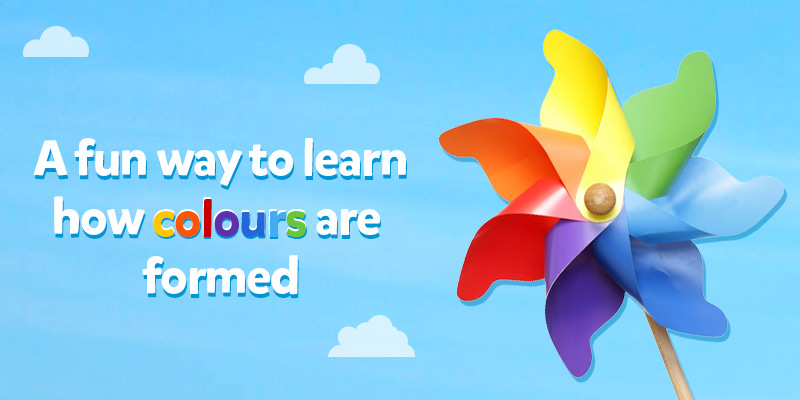 Has your child ever asked you – ‘ What are colours? ‘ or ‘ How does a rainbow have seven colours?’ or ‘What is the colour of my birthday dress?’
Has your child ever asked you – ‘ What are colours? ‘ or ‘ How does a rainbow have seven colours?’ or ‘What is the colour of my birthday dress?’
It’s hard to find a child who isn’t curious about colours! A splash of vivid hues always brighten their day and you must have noticed that they learn better from books or videos that are more colourful.
With colours assuming such significance in their lives, children would naturally be interested to know all about them – such as how they are formed and how one can mix two or more colours together to get a completely new colour.
Here is an idea that will make them learn colours in an engaging, effective and fun way.
You can introduce the colour wheel!
The colour wheel is an easy way to learn primary colours and how they blend to form secondary colours. Even if your children are younger, this is an exciting way to learn about colours.
For your convenience, there will be some teachable moments marked all along the blog.
What do you need to make a colour wheel?
Here is a list of items that you need:
How do you make a colour wheel?
For the parent:
STEP 1: Draw a circle. The radius can be anywhere between 4 to 6 centimeters. Ensure that the circle is big enough for children to paint or colour in.
STEP 2: Divide the circle into six equal parts.

Divide a circle into six parts Source: Creative commons
For the child:
STEP 3: Ask the child to take Red, Blue and Yellow water colours or crayons and paint ALTERNATE portions in the six-part circle.
Teachable moment: As your child paints, tell them that these three colours are the primary colours. Inform them that they form the basis of all colours that they see.
STEP 4: Ask your child to mix any two of the three primary colours together. Here is a list of combinations for your reference:
Red+ Blue
Blue + Yellow
Yellow +Red
You can help your child mix the colours thoroughly. It’s important that the colours are completely mixed in equal proportions to explain how two colours blend to form the third.
STEP 4: Make your child call out the resulting hues that emerge once you mix them:
Blue + Yellow gives Green
Yellow + Red gives Orange
Red + Blue gives Purple

Colour wheel with primary and secondary colours
Teachable moment: Explain to your child that these three colours (Green, Orange and Purple) are secondary colours. They are created when equal amounts of the two primary colours are mixed well.
STEP 5: You can ask the child to paint the actual secondary colours – from their paint box and verify if the mixing has been done right!
STEP 6: For older kids (around seven or eight years of age): you can make them mix ONE primary colour with ONE secondary colour to have six tertiary colours.
This step must be executed completely at your discretion. Your kids might get confused, so we would urge you to teach them one step at a time.
How can you make it interesting?
For parents who don’t mind a mess, we recommend that you use play dough instead of paint or crayons.
Your child would have a good time mixing playdough together and shaping them into triangles that would fit the partitions in the colour wheel.
You can also arrange paintboxes in a circle, if you want it to be clutter-free at the end of the activity

You can make the colourwheel more interesting with coloured boxes or playdough
What does your child learn?
Your child essentially learns the relationship between colours and how to use them.
They can have this trick up their sleeve to conjure the secondary colours if they end up losing any crayon while making art at school.
Your child can also dabble with mixing more colours within the colour wheel to arrive at several hues and use them to create more distinguished and colourful art!
We encourage you to try this with your child during one of the colouring sessions at home and share your experience with us in the comments.
Aparna is a mom, singer and dreamer. At BYJU'S, she writes stories about learning for children. She believes in the power of music, especially ghazal, the magic of the universe and happy learners. When not writing or singing, you will find her intensely engaged in conversations about life and the power of words.